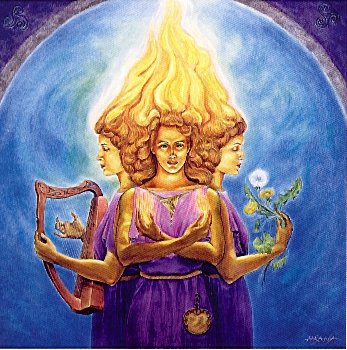|
|
|

 |
| Brighid, Lady of the Hearth by Hrana Janto from http://hranajanto.com/ |
Brighid is the Celtic Goddess of Healers, Poets, Smiths, Childbirth and Inspiration; Goddess of Fire and Hearth and a patron of warfare or 'Briga'. Her soldiers were called Brigands. Her name means "Exalted One". She is also known as Brigantia, Brid, Bride, Briginda, Brigdu, and Brigit in various Celtic dialects. She is said to guard every cradle. Her lore and customs have continued to this day.
She was transformed by the Christians into St. Brigid about 453 C.E. Saint Brighid is known as the patroness of farm work and cattle, and protector of the household from fire and calamity. To this day, one of her most common names in Gaelic is Muime Chriosd, "Foster-Mother of Christ". St. Brighid was said to be the daughter of Dubthach, a Druid who brought her from Ireland to be raised on the Isle of Iona, also called "The Druid's Isle". One story of Saint Brigid is of a woman called Darlughdacha who appears in St. Brigid's community in Kildare as her close companion, sharing Brigid's bed. Darlughdacha, whose name means 'daughter of Lugh', became abbess of Kildare on Brigid's death. The list of saints also give her feast day as February 1. Because of this, there are those who think that Darlughdacha might even be the original name for the goddess Brighid, presumably as Brigid (Exalted One) is a title rather than a name.
It is said that by repeating the genealogy of Brighid, you will always be protected.
The epithet búadach, 'victorious' is one commonly applied to Brighid. Though She has been overshadowed to some extent by Patrick, Brighid is in many senses the national saint of Ireland to this day. Variations of Her name currently used to name Irish girls are in themselves evidence of her enduring importance in the hearts and souls of the Irish. These include Brigid, Breege, Breda, Breed, Bride, and Birdie. Behind the Christian saint, one can still see the Goddess. Brigit was represented in early Irish Christian poetry as Mother of Christ and equal in rank to Mary, and as "The Mary of the Gael". The tradition of Brigit goes deeper as well as further back than that of Patrick, who came from Britain.
In Her earliest references, She appears as Breo-Saighit, the Flame of Ireland, Fiery Arrow. She was a Goddess
of the forge as well, reflecting on Her fire aspect. The stories say that when She was born, a tower of flame
was seen
reaching from the top of Her head to the heavens, and is said to have given
the family
home the appearance of being on fire.
For many centuries, there were 19 virgin priestesses who tended Her eternal flame at
Kildare. They were later replaced with nuns. But through all the centuries, they are said to have sung this song
until the 18th century when Her shrine was closed down by the monarchy:
In an ancient Irish text Giraldus Cambrensis, Brighid and nineteen of Her nuns guarded a sacred fire which burned perpetually and was surrounded by a hedge within which no male might enter. According to the Irish Text "The Book of Dunn Cow", Brighid's sacred number was nineteen, representing the nineteen year cycle of the Celtic Great Year, the time it took from one new moon to the next to coincide with the Winter Solstice. It was believed though, that on the twentieth day of each cycle Brighid Herself would tend the fire Herself.
The household fire is also sacred to Brighid. The fire should be kept going, and each evening the woman of the
household
would cover it over to keep the fire overnight (called 'smooring the fire' in Irish dialect),
asking for the protection of Brighid on all its
occupants. The following is from volume 3 of the Carmina Gadelica:
In Celtic tradition, Brighid is honored with a central well containing candles. It was common to dress the well with flowers and greenery, and frequently coins and other silver objects were offered to the well. Many of Brighid's Holy Wells are still in use, some sacred to Her for thousands of years. Her waters were said to heal all manner of disease.
On Imbolc, in Ireland, they make Brighid's Cross. Brighid's cross is usually made as an even-armed cross woven of reeds. Rites for Brighid have been preserved to this day by the women of the Outer Hebrides. At La Fheill Brighid, the women gather and make an image of the Goddess as Maiden. They dress Her in white and place a crystal over Her heart and place Her in a cradle-like basket. Brighid is then invited into the house by the female head of the household with sacred songs and chanting.
Another tradition is leaving a loaf of bread, pitcher of milk and a candle out for Brighid. Villagers of Avebury climb the earthen mound called Silbury Hill to eat fig cakes and sugar and water. They also climb Cley Hill to play a game within the earthwork at the summit.
There are references in the Carmina Gadelica to the serpent coming out of the mound on Latha Fheill Bride from these
older associations; from this there is conjecture that she may be a Fomorian Earth goddess.
In support of this idea, those who consider this likely refer to an ancient rhyme which is still said in the
Western Highlands:
 Back to the main page...
Back to the main page...